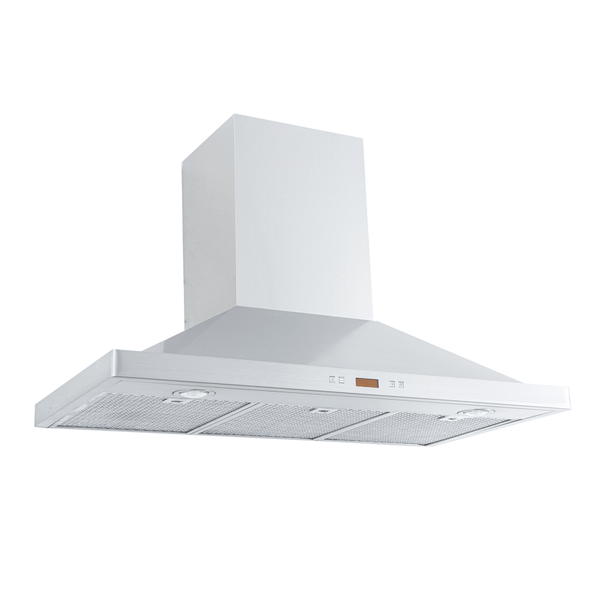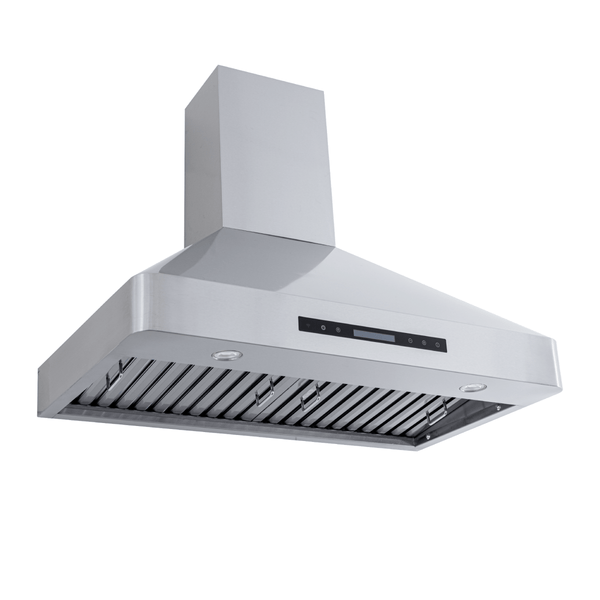CFM, or cubic feet per minute, measures the volume of air that a fan moves. The larger the number, the more air it can move. Bathroom fans, range hoods, carburetors, air compressors, commercial fans, and more measure airflow in CFM.
If you're in the market for a fan, air compressor, or power tools, you may have wondered what CFM stands for.
What does CFM stand for?
CFM stands for cubic feet per minute. It is a measurement that describes the volume of air, measured in cubic feet, a fan moves in one minute.
Typically, CFM is associated with exhaust fans, which run at a few hundred cubic feet per minute. Professional quality fans such as range hoods can move up to 2000+ CFM of air, and commercial hoods reach up to 5000+ CFM. Think of cubic feet per minute as a rate of air flow that tells you how fast unwanted air leaves a room. The more CFM a fan has, the quicker that smoke and steam will leave your home.
You also might see CFM ratings for high-powered specialized equipment. For example, professional duct cleaning companies use machinery upwards of 10 - 20 thousand CFM to clean your ducts thoroughly.
How to Calculate CFM

Now that we've answered 'what is CFM?' we'll discuss how to calculate it.
Gas Range
To calculate the air flow of your fan, divide the total number of BTUs of your range by 100. This will give you the minimum required CFM. So for a range with 90,000 BTUs, you’ll want at least a 900 CFM range hood.
This number only accounts for the heat that your range produces, though, so it is important to consider your cooking habits as well.
If you cook frequently or love Asian food or greasy food, you’ll want to consider at least 1200 CFM with the 90,000 BTU range in this example.
Electric Range
Electric ranges need less CFM since they don’t produce more cooking exhaust and fumes in your kitchen. Instead, electric ranges are powered by a heating element under the burner.
Here’s a table to help you decide on the CFM for your electric cooktop.
Like gas ranges, this is just the lower end. We encourage our customers to buy range hoods with a higher air flow. They typically last longer, give you with more flexibility, and meet customer expectations better than underpowered hoods.
With a higher CFM hood, you’ll always have a powerful max setting available in case of an emergency. Also, you can consistently run your hood on the lower settings to preserve the life of the motor.
For more information on range hood CFM for electric vs. gas cooktops, click here.
What is a good CFM for a range hood?
A good CFM measurement for a range hood is 600 or more. This will accommodate most cooks. With an average size range, a 600 CFM hood typically won’t leave you wanting more, as long as you avoid intense high-heat cooking or foods with strong smells.
For avid cooks, or cooks with larger ranges, 900 CFM is a better option than 600 – and 1200 CFM is even better. A 1200 CFM fan can vent heavy grease and dirt through your exhaust system. It is also sufficient for outdoor hoods over grills.
Is a higher CFM better?
A higher CFM is always better for your kitchen fan. You can always run a high CFM hood on lower settings. It provides great ventilation by moving a heavy amount of air per minute. If you cook often or enjoy Asian cooking, a high powered fan is essential to keep grease out of your kitchen exhaust system.
Also, depending on your room size, a higher CFM may be necessary. The larger the room, the higher the volume of air you need for your fan. Residential kitchen fans produce up to 2000 CFM while commercial hoods produce thousands of CFM. But these fans are not designed for your home.
Keep in mind that not all manufacturers sell 2000 CFM hoods. Most hoods are 600 CFM and below. These hoods are not as versatile because the lower speeds lack power. With a high powered hood, you can run it at lower speeds all the time. This way, it will last much longer in your kitchen.
The larger the kitchen range, the more air your hood should move. But, you need to make sure you have enough space on your wall or under the cabinets. Over a larger range, coverage is even more important. We suggest buying a hood that is six inches larger than the cooktop. If you have space, over six inches is recommended for your kitchen fan.
What is CFH?
Range hoods are measured in CFM (cubic feet per minute), but sometimes you’ll see equipment measured in cubic feet per hour or CFH. This will be a much larger number by comparison to a CFM reading: 60 times larger, to be exact since there are 60 minutes in one hour.
Gas lines are a good example of equipment that is measured in cubic feet per hour. This rating tends to be quite low, especially in residential applications because gas is being moved, not air. Gas lines must adhere to strict code requirements and safety regulations to ensure safety for all residents. Your typical residential gas line will measure approximately a few hundred cubic feet per hour (CFH).
While this may seem low, one cubic foot per hour of gas supplies approximately 1,024 BTUs for your gas appliances in the home. So, to determine the capacity of your gas line in BTUs, multiply the CFH by 1,024. Your gas appliances, if they are able to, can use up to this amount of BTUs in total. This is the max number of BTUs your gas line can handle.
For example, if your gas line is 200 CFH, then you can hook up gas appliances that add up to 200*1,024 = 204,800 BTUs.
Note that this is simply an approximation. Depending on the pressure of your natural gas line, you may be able to hook up more gas appliances. Consult a licensed professional or contractor to determine the CFH and BTUs capacity of your gas line before you install additional gas appliances.
Thanks for stopping by our article on CFM. To learn more about CFM, check out our articles below.
Related Articles
Best 600 CFM Range Hoods and Buyer’s Guide
Is 400 cubic feet per minute enough for my kitchen fan?
Is 300 CFM enough for my kitchen fan?
What is CFM?
What does CFM stand for?
What is a good CFM for a range hood?
For avid cooks, or cooks with larger ranges, 900 CFM is a better option than 600 – and 1200 CFM is even better. A 1200 CFM fan can vent heavy grease and dirt through your exhaust system. It is also sufficient for outdoor hoods over grills.
Is a higher CFM better?
What is CFH?
Gas lines are a good example of equipment that is measured in cubic feet per hour. This rating tends to be quite low, especially in residential applications because gas is being moved, not air. Gas lines must adhere to strict code requirements and safety regulations to ensure safety for all residents. Your typical residential gas line will measure approximately a few hundred cubic feet per hour (CFH).












